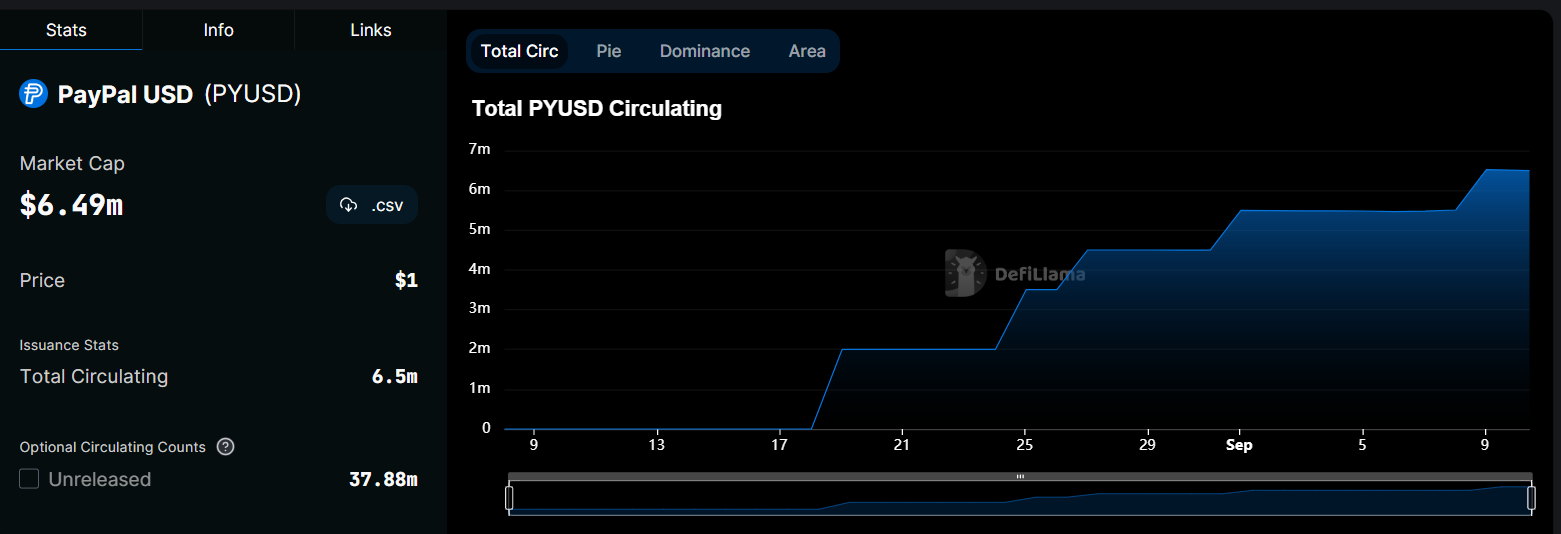PayPal Stablecoin PYUSD is struggling with adoption four weeks into launch despite listing on several major crypto exchanges.
The dollar-pegged stablecoin has a supply of $44.37 million, but less than 20% of this supply has circulated, which means the majority are unreleased.
SponsoredOnly $6.5 Million PYUSD in Circulation
Data from Defillama shows that only $6.49 million PYUSD stablecoin is in circulation presently. This is incredibly low, given that it has been over a month since the stablecoin launched.
Interestingly, this is not its peak circulating supply. The circulating supply peaked at $6.52 million on September 9, suggesting a slight decline over the last 24 hours. Such a decline is not a good sign for a stablecoin in its early stages of adoption.
Read more: What Is a Stablecoin? A Beginner’s Guide

Meanwhile, on-chain data shows that Paxos Treasury, which issued the stablecoin and one unknown address, holds $37.88 million of the total supply. Per Etherscan, 534 addresses, including Paxos treasury, and addresses of centralized exchanges such as Coinbase, BitMart, Gate.io, Huobi, and Crypto.com dominate the list of its holders.
Comparison with Similar Stablecoins
The adoption of PYUSD has been slower than recently launched stablecoins, with Aave GHO being a noteworthy example. Within one month of its introduction, Aave GHO saw its circulating supply surge from its initial value to a peak of $25 million.
SponsoredPresently, when ranked by market capitalization, PYUSD is number 61 among stablecoins. This places it in the same category as other relatively unknown stablecoins like RAI Reflex Index, Parallel PAR, and NXUSD.
Read more: What Are Algorithmic Stablecoins?
Considering the high expectations and anticipation surrounding its launch, PYUSD’s performance thus far has been underwhelming. Many had anticipated that a stablecoin backed by a payment giant like PayPal would present stiff competition for established counterparts such as Tether (USDT) and Circle (USDC).
Is There Room For Growth?
Despite the relatively low adoption, some believe the PYUSD could still grow. They attribute the limited success to its short existence and the absence of news about its development until the launch.
However, Bank of America does not expect growth in the near term. A report from the BOA predicts that PYUSD will struggle against major stablecoins. This is because of the indifference of crypto natives to PYUSD and the fact that major stablecoins currently in existence are yield-bearing.
“Over the longer term, we expect PYUSD to experience additional adoption headwinds as competition from CBDCs [central bank digital currencies] and yield-bearing stablecoins increases. Investors may have been fine holding non-yield-bearing stablecoins, such as USDT and USDC, when rates were close to zero, but yield-bearing stablecoins will likely become increasingly available and attractive with short-term rates above 5%.”
Read more: 10 Platforms That Provide the Best Interest Rate on Stablecoins
The report also pointed to incompatibility with wallets, absence of trading pairs, and lack of new functionality as reasons for its slow adoption.

